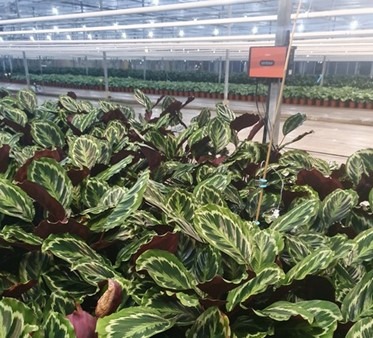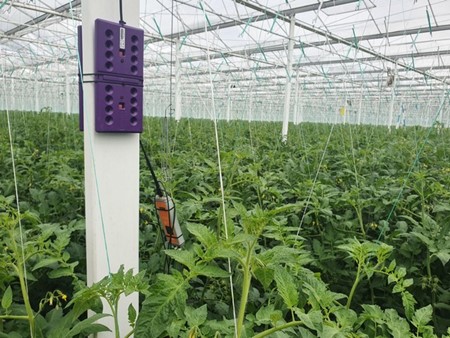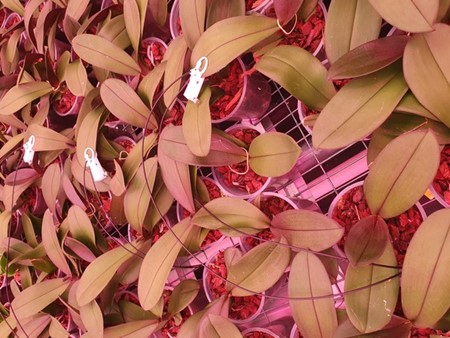published in groentennieuws.l
Growers cannot answer the question of what the crop does if something changes in the lighting without sensors. An important sensor to visualize this is the photosynthesis sensor. It measures the photosynthesis efficiency of a crop, in real time. With the shift from HPS to LED lighting or hybrid lighting, the sensor is increasingly becoming an important tool, but the current high energy prices make good measurement even more important, especially real-time measurement.
“Growers who are currently rethinking their strategy want to be able to quickly adjust their lighting, while maintaining quality and production,” says technical manager and senior researcher Arie Draaijer of sensor manufacturer Sendot. “Anyone who starts measuring will see that many savings are possible. Saving even tenths of a percent on energy is currently already yielding serious money.”

Growers have already discovered in recent years that it is possible to measure photosynthesis efficiency. Measuring photosynthesis efficiency is no longer just a matter for researchers. Sensors have become increasingly affordable. “With current energy prices, a grower can easily pay off the investment in some of our affordable sensors this winter.” More and more growers have already invested in photosynthesis sensors, but the energy crisis will undoubtedly be an enormous extra stimulus, Arie expects. “We are currently seeing a lively interest.”
CAM plants
How crops deal with lighting differs per crop. Growers of so-called CAM plants, an abbreviation for Crassulacean Acid Metabolism, were also working on photosynthesis efficiency without high energy prices. Arie gives phalaenopsis growers as an example, who can be counted among the 'early adapters' of measurement technology. “They have come a long way in measuring and calculating changes in lighting on growth and production.”
CAM plants, including orchids and many other ornamental plants, close their stomata during the day to grow without drying out. They cannot absorb CO2 with closed stomata. They also grow during the day with the CO2 they absorb at night. But when the stored CO2 stock is exhausted, it stops. Extra lighting therefore makes no sense. “That's why these growers have started to pay very close attention to what the plant can still handle in terms of lighting. Our sensors, which measure in real time, help growers to make this clear.”

Game
The situation is different for production crops such as tomatoes, cucumbers, lettuce or strawberries, and currently also in greenhouse vegetable cultivation in which winter lighting is used. These crops convert CO2 directly into growth. Yet it is here too that growers benefit from insight into photosynthesis efficiency, according to Arie. “In principle, every grower is always optimizing, including his energy consumption. With the current high energy prices, this is only more the case. Growers are rethinking their lighting strategy, but want to do so without compromising too much on production and quality.”
He points out that the above-described effects of changes in lighting on a crop in, for example, tomato or cucumber are more nuanced. “The game of lighting, photosynthesis efficiency, production and greenhouse climate is more complicated here. That is why it took about thirty years to arrive at the current optimized strategies for lighting with HPS, while it has now also taken about ten years of research with LED to arrive at an optimal schedule here too. Growers play here with, among other things, temperature in the head. This is also changing due to the change in fixtures, so people are now looking for the optimal again.”

Measure and react immediately
Due to the possibility of real-time measurement, growers can (of necessity) take steps quickly in the current energy crisis. According to Arie, there are still very few growers with a scenario for the current energy crisis that states exactly what less lighting does to production. “And even in science there is still a lot unknown about how crops react exactly. Nobody has taken this into account to this extent.”
He gives an example. “If you continuously monitor the energy prices and want to immediately anticipate this by switching off the lamps for a while at very high price peaks, it can happen in the current dynamic energy market that the lamps are switched off or dimmed several times a day. However, there is still very little insight into what exactly that means with production and quality. And I don't mean finding out after a few weeks that fewer trusses are produced, but seeing the effect of turning the buds on the crop in real time. That effect is very different when you switch off the lamps when there is more light from outside, as already happens, than when you switch off the lamps when there is no extra light from outside. That is what you are now forced to see happening and so there is still a lot to discover and learn.”
All crops
Sendot's photosynthesis sensors can be used in all possible greenhouse crops. Erwin Grafe, Commercial Manager at the sensor developer: “The grower places the sensor on the leaf. We have various solutions for this. A standard clip is available here for most leaves. You place it high in the crop on a leaf that contributes a lot to the production of the crop. For crops that are not so high growing, you can choose the right leaf for this, depending on the age.
Where that leaf is not strong enough, for example with some herbs or leafy crops, you can place the sensor on a stick and the clip around the leaf. This is currently still a challenge in the multi-layer cultivation of certain young leafy crops and herbs. Young leaves are especially vulnerable here. There it therefore requires a little more attention from the grower, but here too the energy savings that growers can achieve quickly pay off.”

A few sensors are often sufficient. “Our advice is often: start small by collecting data and scale up as soon as you get a better grip on the data. We also help with that. In a greenhouse with one crop and the same conditions, a few sensors can already make a big difference. Where growers have several crops that respond differently to lighting, it can pay off to invest in more sensors. In all cases it is true that sometimes large and sometimes only small savings together, especially now, seriously add up to the current energy prices.”
For more information:
Sendot info@sendot.nl www.sendot.nl
